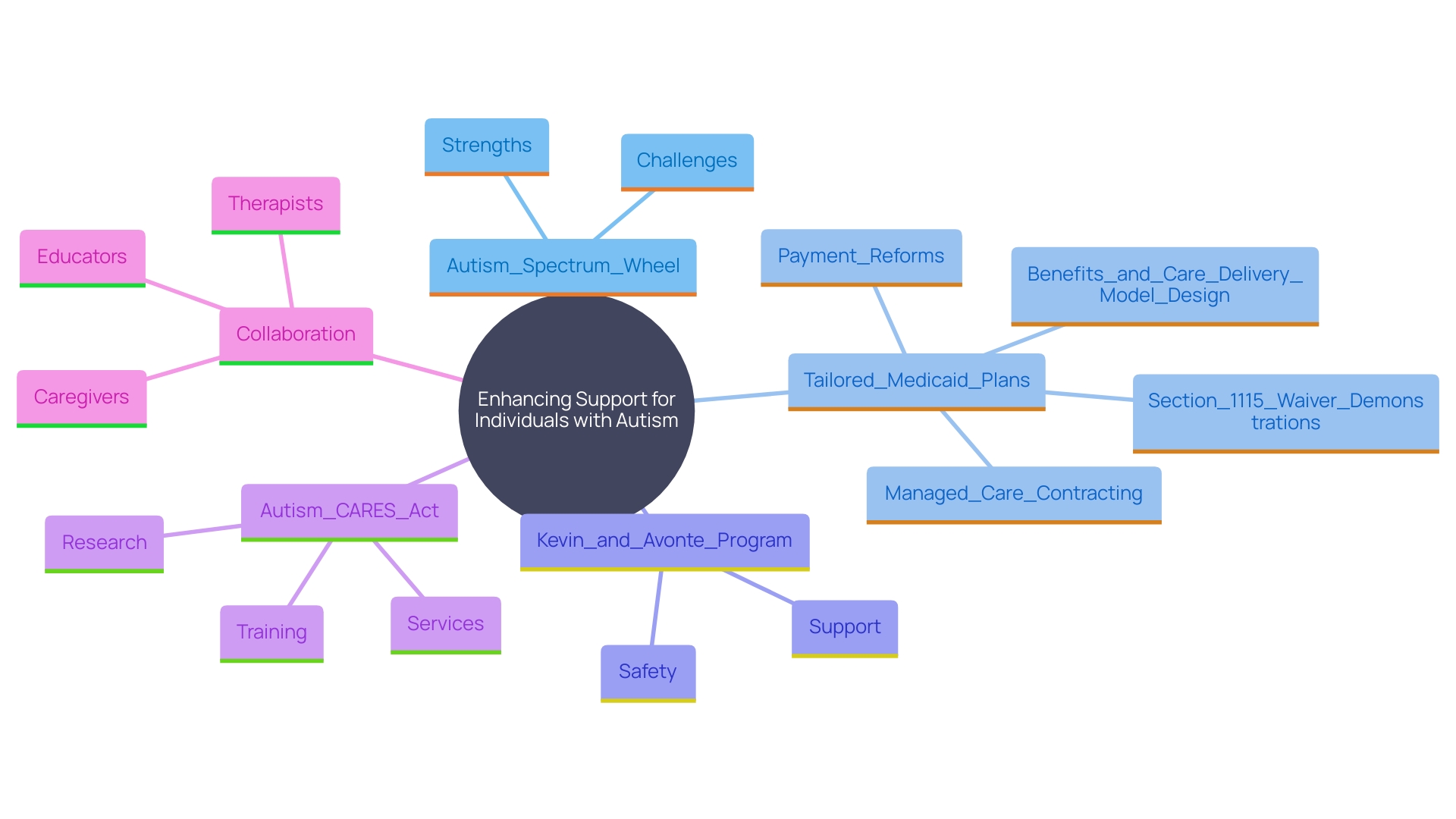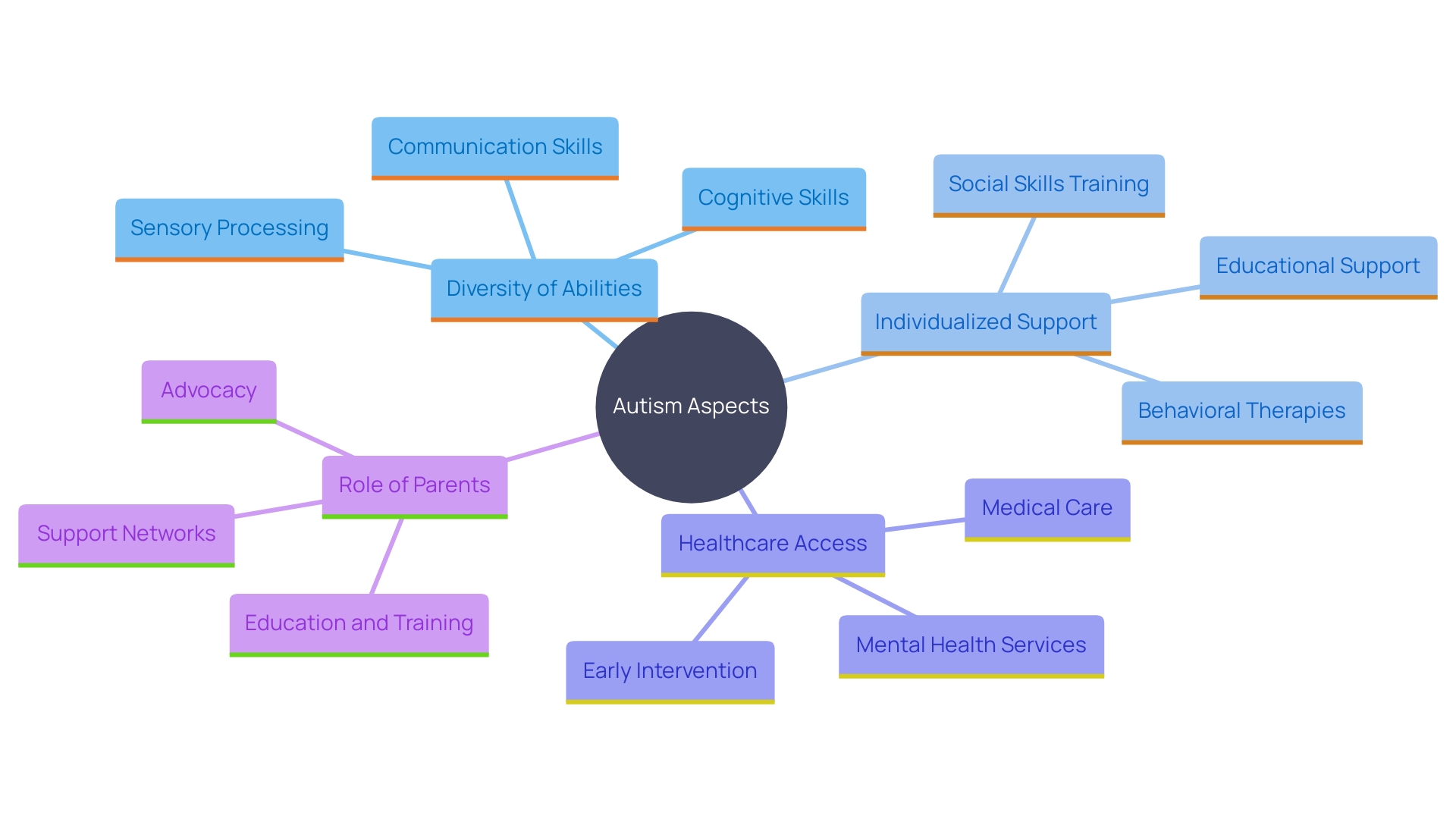Introduction
Navigating the complexities of Autism Spectrum Disorder (ASD) can be daunting for parents and caregivers, yet understanding its diverse characteristics is the first step toward effective support. Autism presents a wide range of symptoms, including challenges in social communication and repetitive behaviors, which can significantly impact a child's ability to engage with their environment. Recognizing these unique traits is crucial for tailoring interventions that promote development and well-being.
One powerful tool in this endeavor is the Autism Spectrum Wheel, a comprehensive visual aid that breaks down the multifaceted nature of autism. Unlike traditional linear models, the wheel offers a nuanced view of how individuals may exhibit varying degrees of traits across different domains, thereby simplifying the complexity of the spectrum and facilitating better understanding and support.
Utilizing such tools can significantly enhance diagnosis and intervention strategies by highlighting an individual's strengths and challenges. This approach ensures that caregivers can provide personalized support, fostering effective communication among parents, educators, and therapists. Furthermore, understanding the diversity within the autism spectrum—from high-functioning individuals to those requiring substantial support—enables parents to advocate more effectively for their children’s needs, ensuring they receive the necessary resources for a fulfilling life.
By delving into these aspects, the article aims to equip parents with the knowledge and tools to support their autistic children, promoting an inclusive environment that values their unique contributions and enhances their quality of life.
Key Characteristics of Autism
Autism Spectrum Disorder (ASD) presents a diverse array of symptoms and behaviors that vary significantly among individuals. Key characteristics include challenges in social communication, repetitive behaviors, and restricted interests. These can manifest in various ways, such as difficulty in understanding social cues, sustaining eye contact, or displaying intense focus on specific topics. Dr. David (Dan) R. Offord, a renowned child psychiatrist, emphasized the importance of fair and well-supported participation in all life domains for children with disabilities, including those with autism. Identifying and responding to these distinct characteristics is essential for parents and caregivers to customize effective assistance and interventions. Ensuring that autistic children and youth have the necessary resources and support not only aids their development but also promotes equity and mental health within the community. This holistic approach is essential, as it recognizes the unmet needs and strengths of those with autism, thereby reducing stress and enhancing family well-being.
The Autism Spectrum Wheel: A Comprehensive Visual Tool
The Spectrum Wheel offers a thorough visual depiction of the varied characteristics and experiences within the spectrum. Unlike conventional linear models, this wheel emphasizes the complex nature of the condition, demonstrating how people may display varying degrees of characteristics across different areas. This tool simplifies the complexity of the autism spectrum into more digestible segments, enabling parents and professionals to better understand and visualize the unique profiles of people with autism. As Dr. David (Dan) R. Offord once stated, "Engaged, peaceful and well-supported participation of children and youth with disabilities in the major school, home, and leisure domains of their lives is a fundamental determinant of mental health." The Autism Spectrum Wheel, by breaking down these complexities, aids in ensuring that caregivers have the resources they require to assist their children’s healthy development and well-being.

Benefits of Using the Autism Wheel for Diagnosis and Support
Utilizing the Autism Spectrum Wheel can significantly enhance the diagnostic process and support strategies by providing a comprehensive view of an individual's strengths and challenges. This tool encourages a more personalized approach, allowing caregivers to identify specific areas of need while also recognizing strengths. For instance, state Medicaid plans and waivers offer tailored approaches to address challenging behaviors, ensuring access to essential care and services for the autism community. By promoting better communication among parents, educators, and therapists, the Autism Spectrum Wheel ensures more effective interventions and assistance systems.
Dr. Laura McKenna, with three decades of experience in education, emphasizes the importance of using tools like the Autism Spectrum Wheel to assist young adults as they transition to life after high school. Her regular webinars highlight the best programs available, ensuring parents are well-informed.
The Kevin and Avonte Program, named in honor of two autistic teens, exemplifies a focused approach to severe behaviors, such as wandering. Since its inception, it has awarded $10.3 million to 77 grant recipients, providing critical resources for locating and recovering individuals who have wandered, and proactively increasing public awareness and training.
The Autism CARES Act has allocated $5 billion toward research and services related to developmental disorders since 2006, enhancing our comprehension and assistance for individuals with these conditions. However, there is still a requirement to maintain and expand funding for programs that address intense behaviors. As we promote the reauthorization of the Autism CARES Act, it is essential to keep improving resources like the Autism Spectrum Wheel to assist the whole community effectively.

Understanding the Diversity of Autism: From High Functioning to Severe Cases
Autism is a highly diverse spectrum, including people with a wide variety of abilities and requirements. Certain people on the spectrum thrive in particular fields and can operate on their own, while others might need significant assistance in their everyday tasks. This diversity is a reflection of neurodivergence, which highlights the unique ways in which each person processes information and interacts with the world. Recognizing this variability is crucial for parents, as it enables them to advocate effectively for their child's specific needs.
Understanding the unique profile of each child with autism is essential for securing the right resources and support. For example, the recent consensus statement published in Pediatrics underscores the necessity of healthcare that is accessible, humane, and effective for all individuals, including those with neurodevelopmental disabilities. It requires enhanced training for healthcare providers, improved communication with families, and proactive planning to ensure that patients receive the accommodations they require.
Moreover, autistic children and youth who experience co-occurring emotional and behavioral problems are at high risk of exclusion from meaningful daily social participation. Tackling their unfulfilled requirements and acknowledging the strengths they contribute to their communities are essential for their mental health and overall well-being. As Dr. David H. Roberts from Harvard Medical School highlights, autistic people require access to quality medical care throughout their lives, not just during childhood.
By understanding the broad spectrum of autism and the unique needs of each individual, parents can better navigate the complexities of diagnosis, intervention strategies, and assistance services. This knowledge empowers them to advocate for their children effectively, ensuring they receive tailored support that enhances their development and quality of life.

Conclusion
Understanding Autism Spectrum Disorder (ASD) is essential for parents and caregivers striving to provide the best support for their children. The diverse characteristics of autism, including challenges in social communication and repetitive behaviors, highlight the need for tailored interventions. By recognizing the unique traits of each child, caregivers can better address their specific needs, promoting both development and emotional well-being.
The Autism Spectrum Wheel serves as a powerful visual tool that simplifies the complexities of autism. It allows for a nuanced understanding of how individuals experience varying traits across different domains. This comprehensive perspective not only aids in diagnosis but also fosters effective communication among parents, educators, and therapists, ensuring that children receive personalized support.
Utilizing the Autism Spectrum Wheel enhances the ability to identify strengths and challenges, facilitating the creation of more effective intervention strategies. Programs like the Kevin and Avonte Program and the ongoing support from the Autism CARES Act exemplify the importance of targeted resources in addressing the needs of the autism community. Continued advocacy for these initiatives is crucial to ensure that all individuals with autism receive the support they require.
Finally, embracing the diversity within the autism spectrum empowers parents to advocate effectively for their children. By understanding the varying needs and strengths of autistic individuals, caregivers can secure the resources necessary for fostering a fulfilling life. This commitment to advocacy not only enriches the lives of autistic children but also promotes a more inclusive society that values their unique contributions.




